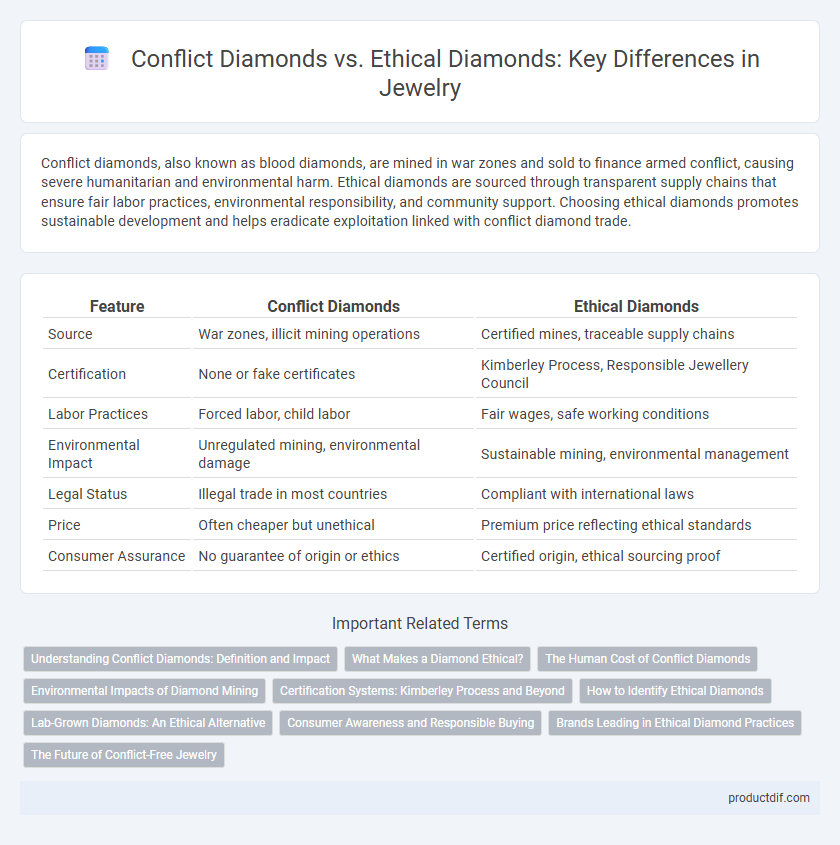Conflict diamonds, also known as blood diamonds, are mined in war zones and sold to finance armed conflict, causing severe humanitarian and environmental harm. Ethical diamonds are sourced through transparent supply chains that ensure fair labor practices, environmental responsibility, and community support. Choosing ethical diamonds promotes sustainable development and helps eradicate exploitation linked with conflict diamond trade.
Table of Comparison
| Feature | Conflict Diamonds | Ethical Diamonds |
|---|---|---|
| Source | War zones, illicit mining operations | Certified mines, traceable supply chains |
| Certification | None or fake certificates | Kimberley Process, Responsible Jewellery Council |
| Labor Practices | Forced labor, child labor | Fair wages, safe working conditions |
| Environmental Impact | Unregulated mining, environmental damage | Sustainable mining, environmental management |
| Legal Status | Illegal trade in most countries | Compliant with international laws |
| Price | Often cheaper but unethical | Premium price reflecting ethical standards |
| Consumer Assurance | No guarantee of origin or ethics | Certified origin, ethical sourcing proof |
Understanding Conflict Diamonds: Definition and Impact
Conflict diamonds, also known as blood diamonds, are mined in war zones and sold to finance armed conflict against governments, causing severe human rights abuses. These diamonds contribute to violence, exploitation, and environmental destruction, often involving forced labor and child soldiers. Understanding the origin and impact of conflict diamonds is crucial for promoting ethical sourcing and responsible jewelry consumption.
What Makes a Diamond Ethical?
Ethical diamonds are sourced through transparent supply chains that ensure no involvement in conflict zones, human rights abuses, or environmental harm. Certification programs like the Kimberley Process and independent audits verify that these diamonds are mined responsibly and traded legally. Consumers seeking ethical diamonds prioritize fair labor practices, community benefits, and environmental stewardship in the entire diamond production lifecycle.
The Human Cost of Conflict Diamonds
Conflict diamonds, also known as blood diamonds, are mined in war zones and sold to finance armed conflict, leading to severe human rights abuses including forced labor, violence, and displacement of local communities. Ethical diamonds are sourced through transparent supply chains that ensure fair labor practices, environmental sustainability, and community development. The human cost of conflict diamonds extends beyond violence to long-term social and economic damage in affected regions.
Environmental Impacts of Diamond Mining
Conflict diamonds, often sourced from war zones, disrupt ecosystems through unregulated mining practices that cause deforestation and soil erosion. Ethical diamonds, mined with strict environmental regulations, minimize habitat destruction and carbon emissions by employing sustainable techniques. Choosing ethical diamonds supports biodiversity conservation and reduces long-term ecological damage often associated with conflict diamond extraction.
Certification Systems: Kimberley Process and Beyond
The Kimberley Process Certification Scheme (KPCS) is a key international initiative designed to prevent conflict diamonds from entering the mainstream market by regulating the trade and requiring certification for rough diamonds. Beyond the Kimberley Process, ethical diamonds emphasize broader standards such as traceability, environmental sustainability, and fair labor practices, often verified by independent organizations like the Responsible Jewellery Council (RJC) or through blockchain technology ensuring transparency across the supply chain. These certification systems aim to guarantee that diamonds are sourced responsibly, addressing both human rights concerns and environmental impact within the jewelry industry.
How to Identify Ethical Diamonds
Ethical diamonds are sourced through transparent supply chains that comply with the Kimberley Process Certification Scheme, ensuring they are conflict-free. Consumers can identify ethical diamonds by seeking certifications from recognized organizations like Fairtrade or the Responsible Jewellery Council, which verify responsible mining practices. Using blockchain technology, some jewelers provide traceability data that confirms the diamond's origin and ethical credentials.
Lab-Grown Diamonds: An Ethical Alternative
Lab-grown diamonds offer a sustainable and ethical alternative to conflict diamonds, eliminating the environmental damage and human rights abuses often associated with mined stones. These diamonds are chemically and physically identical to natural diamonds but are produced in controlled laboratory environments, ensuring transparency and traceability. Growing in popularity, lab-grown diamonds provide consumers with guilt-free luxury while supporting fair labor practices and reducing ecological impact.
Consumer Awareness and Responsible Buying
Consumers are increasingly prioritizing ethical diamonds over conflict diamonds, driven by growing awareness of human rights abuses in diamond mining. Certifications like the Kimberley Process and brands promoting traceability enable responsible buying decisions that support sustainable and conflict-free supply chains. Educated consumers demand transparency and environmental stewardship, reshaping the jewelry market towards more ethical sourcing practices.
Brands Leading in Ethical Diamond Practices
Brands leading in ethical diamond practices prioritize transparent sourcing, ensuring their diamonds are conflict-free and certified through rigorous standards like the Kimberley Process. Companies such as Brilliant Earth and De Beers integrate blockchain technology to trace the origin of each stone, providing consumers with verifiable ethical guarantees. These brands also invest in community development and environmental sustainability, setting industry benchmarks for responsible diamond mining and trade.
The Future of Conflict-Free Jewelry
The future of conflict-free jewelry hinges on the widespread adoption of ethical diamonds sourced through transparent supply chains and verified by blockchain technology. Innovations in lab-grown diamonds offer a sustainable alternative that eliminates the environmental and human rights issues associated with conflict diamonds. Consumer demand for traceability and stringent certification standards continues to drive the jewelry industry toward fully conflict-free practices.
Conflict Diamonds vs Ethical Diamonds Infographic

 productdif.com
productdif.com